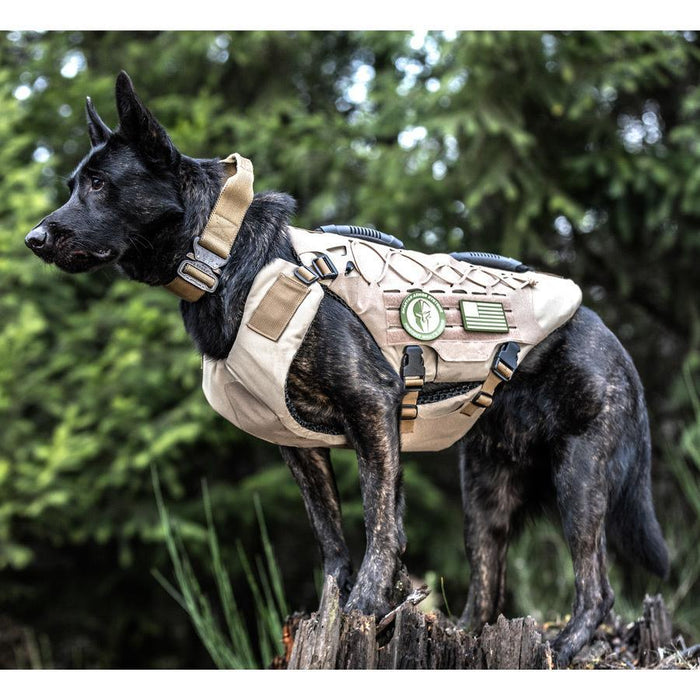SOURCE: AFI


The Indian Army’s canine warriors, long celebrated for their bravery in counter-terrorist operations and disaster relief missions, are set to receive a significant upgrade in protection and care. Recognizing the invaluable role these dogs play as force multipliers, the Army, through its Remount Veterinary Corps (RVC), is developing advanced protective devices—including lightweight bulletproof vests and smart collars—to mitigate casualties and enhance their operational effectiveness. These innovations aim to address the harsh realities of military service, where dogs face extreme weather, physical exertion, and life-threatening combat environments.
Military dogs have been integral to the Indian Armed Forces, Central Armed Police Forces (CAPFs), and law enforcement agencies for decades. Breeds like German Shepherds, Belgian Malinois, and Labradors excel in roles such as patrolling, explosive detection, search and rescue, and neutralizing threats. Their contributions have been pivotal in operations along the Line of Control (LoC), in counter-insurgency missions in Jammu and Kashmir, and during disaster relief efforts like the 2023 Uttarakhand floods. Some have even served overseas with Indian peacekeeping contingents, earning gallantry awards for their courage.
Yet, this service comes at a cost. Over the years, several canine warriors have fallen to enemy fire during search operations, house-clearing missions, or while shielding soldiers from terrorists. Their sacrifices—often saving human lives—highlight the need for better protection and health monitoring to ensure their safety and longevity in service.
One of the most promising innovations is the development of smart collars, akin to fitness trackers for humans. These high-tech devices will monitor critical health parameters such as body temperature, pulse, respiration rate, heart rate variability, and calorie expenditure in real time. “Operational deployment exposes dogs to extreme conditions—heat stress, fatigue, respiratory issues, and cardiac strain are common,” explained an RVC officer. “A smart collar would alert handlers to any abnormality, enabling timely intervention.”
Currently, dog handlers rely on experience and visual cues to assess a dog’s condition—a method that can falter under the chaos of combat or when symptoms are subtle. Delayed or inaccurate responses can jeopardize a dog’s health, especially during prolonged missions in toxic or high-altitude environments like Siachen. The smart collar, still in the design phase, promises to revolutionize this process by providing data-driven insights, ensuring these canine soldiers remain fit for duty.
Complementing the smart collars is a new initiative to equip military dogs with lightweight, modular bulletproof vests. These vests, designed to weigh less than 2 kilograms, will protect the dogs’ torsos from bullets and shrapnel during high-risk operations, such as anti-terrorist missions or LoC patrols. While the Army has procured a limited number of imported vests, their weight—often exceeding 3-4 kilograms—and high cost have proven impractical. “Heavy vests hinder a dog’s agility and effectiveness, which are their greatest assets,” the RVC officer noted. “We’re working on a solution that balances protection with mobility.”
The indigenous vests, still in development, aim to address these shortcomings. Their modular design will allow customization based on mission needs, ensuring dogs can sprint, climb, and maneuver without encumbrance. This innovation is particularly timely, given the rising threats dogs face in conflict zones. In recent years, canine casualties have included heroes like Axel, a Belgian Malinois killed in a 2022 Baramulla encounter, and Zoom, a Lab who succumbed to injuries after flushing out terrorists in 2021—both posthumously honored for their valor.
Dogs are more than loyal companions; they are strategic assets. Their acute senses detect explosives and hostiles far beyond human capability, while their smaller size and speed make them elusive targets. When equipped with cameras, they provide real-time tactical intelligence from hard-to-reach areas, enhancing situational awareness. In disaster scenarios, their search-and-rescue skills have saved countless lives, navigating rubble where humans cannot.
This versatility has cemented their status as force multipliers. In counter-terrorism, a single dog can replace multiple soldiers in sniffing out threats or clearing buildings, reducing human exposure to danger. Their psychological impact—deterring adversaries with their presence—further amplifies their value. Protecting these assets with advanced gear is, therefore, a strategic imperative.
NOTE: AFI is a proud outsourced content creator partner of IDRW.ORG. All content created by AFI is the sole property of AFI and is protected by copyright. AFI takes copyright infringement seriously and will pursue all legal options available to protect its content.